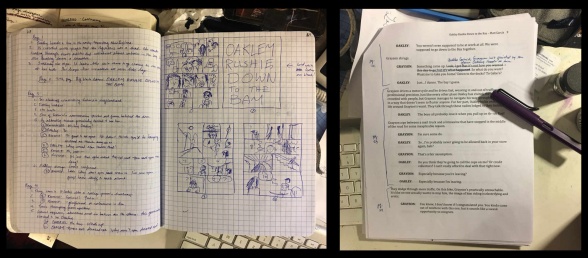This year, I finished a comic called “Oakley Rushie Down to the Bay.” Nominally a comedy, the story focuses on a young woman trying to wrangle her friends together to uphold a tradition, even though none of these people really want to talk to her at that moment. It took me shy of 100 days to draw and maybe even longer to write, as it underwent numerous permutations. (I’m looking back through my old notebooks and at one point, it was about kids working in a pizzeria.) I finished the book before I turned 30, so I guess you can make of that what you will.
“Oakley” is my second full-length comic, after “The Literary Intellectual Team”, which is horrible (though still available to read if you like suffering). When I started it, I was reading a lot of manga, and wanted to push myself to use the bigger images and more frantic pacing. Inspired by Emily Carroll and Abby Howard as well, who posted their work as scenes rather than individual pages, I tried to think of it less as writing for the page as writing for the sequence. Also, because Hail, Caesar! came out this year, I went on a big Coen Brothers kick. Looking at the work now, months after it’s been finished and I’m working on developing a new project, it’s ridiculously easy to see what I was stealing from scene to scene.
As always, I wrote the first draft of “Oakley” in my notebooks, which I then typed up as a full script.

After that, I thumbnailed the thing in Manga Studio, again drawing it more out by the scene. I did this on one big canvas, so when I zoomed all the way back out, I could see how everything was playing out. Even when I’m writing for other people, I don’t usually put down panel indicators. I like finding the beat of the story as I’m sketching it out, but also like having the structure from the script.

All right, after I finished that, after I found my rhythms and sequencing, I broke down the thumbnail script into individual pages. I am very good at making my workflow as impractical as possible.
I drew the book on mixed media 11×14 paper, mostly with a G-nib dip pen and Sumi ink. I used Pitt Pens for the lettering snd some finer details. In Manga Studio, I made slight tweaks and fixes and added the panel borders. When I first started trying to draw comics, I taught myself how to ink with a brush, mostly because that’s what Paul Pope and Jeff Smith used, but I felt the pen line brought a different energy to the page, a way to match the manic rhythms of Oakley’s day. Throughout this whole process, I also learned how to use new techniques for capturing lighting and expression. (Shout out to Alphonso Dunn, especially.) In fact, some of the most fun I’ve had going through this again is finding the places where I suddenly started applying something new.

It did take me a while to find a through-line that meant something to me. In previous iterations, I struggled to connect with any of the story material, and I wasn’t producing anything that I felt was worth sitting down and working on for, like, a third of a year. What finally opened the doors, as it were, was when my best friend moved away. She got a better job in a bigger city, and I put everything I was feeling into the characters, those feelings of abandonment, pride, anger, melancholy, and happiness for her accomplishments. In the days leading up to her departure, I simultaneously wanted to see her all the time and also not be there to get used to not being able to just go hang out whenever. I think for all the faults I’m finding with it right now, all the memories of having to redraw sequence after sequence until I tuned it into something kind of workable, of my evolving ability to actually draw, “Oakley Rushie Down to the Bay” will have a special meaning to me because of that.
Part of the reason I write about comics is because I make comics. Writing a weekly review allows me to actively look at a page, see what works, what might not be appropriate for that scene, and generally find ideas to utilize myself. No work exists in a vacuum and there’s all sorts of interesting stuff to cull from. (And maybe muddle, I don’t know.) There’s bound to be something fascinating in everything from the most mainstream superhero book out there to the smallest indie comic you stumbled across on Tumblr late one night.
It’s easy to be all, “Oh, you’re pimping your own work on another platform you happen to write for,” and yeah, okay, I’m doing that. But making comics is as much a part of my comics experience as reading them. “Oakley Rushie Down to the Bay” was a huge part of my year, and I kind of just want to share it wherever I get the chance.






